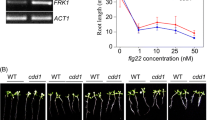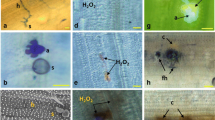Abstract
PR-1 has been extensively used as a marker for salicylic acid (SA)-mediated defence and systemic and local acquired resistance. The Arabidopsis Genome Project annotates At2g19990 as PR-1. This gene is also identified as PR-1 in two “full genome” Arabidopsis microarrays, and TAIR cites approximately 60 articles to describe its patterns of expression. However, most of these citations are incorrect; the probes used were not At2g19990, but a homologous gene At2g14610, which is annotated as “PR-1-like”. Because of the potential for confusion, we analyzed the expression of both genes in Arabidopsis thaliana (L.) Heynh. At2g14610 (PR-1-like) showed the archetypal patterns of SA-responsive expression: mRNA levels increased following SA-treatment, inoculation with an avirulent (but not a virulent) strain of Pseudomonas syringae, and in wild-type (but not NahG) Arabidopsis infected with cauliflower mosaic virus (CaMV). In cpr5 mutants it was expressed constitutively. In contrast, expression of At2g19990 (annotated as PR-1) was detectable in neither SA-treated Col-0 nor in cpr5. Infection by virulent and avirulent isolates of P. syringae up-regulated expression, but to a similar level, and infection by CaMV induced a modest increase in expression in both the wild type and NahG. At2g19990, although pathogen responsive, does not show the SA-dependent patterns of expression expected from a member of the PR-1 regulon, and its annotation as “PR-1” is inappropriate. The annotations should identify At2g14610 as the authentic PR-1.

Similar content being viewed by others
Abbreviations
- CaMV:
-
Cauliflower mosaic virus
- PR:
-
Pathogenesis related
- SA:
-
Salicylic acid
References
Bowling SA, Clarke JD, Liu YD, Klessig DF, Dong XN (1997) The cpr5 mutant of Arabidopsis expresses both NPR1-dependent and NPR1-independent resistance. Plant Cell 9:1573–1584
Cecchini E, Gong ZH, Geri C, Covey SN, Milner JJ (1997) Transgenic Arabidopsis lines expressing gene VI from cauliflower mosaic virus variants exhibit a range of symptom-like phenotypes and accumulate inclusion bodies. Mol Plant Microbe Interact 10:1094–1101
Cecchini E, Al-Kaff N, Bannister A, McCallum DG, Maule AJ, Milner JJ, Covey SN (1998) Pathogenic interactions between variants of cauliflower mosaic virus and Arabidopsis. J Exp Bot 49:731–737
Clarke JD, Aarts N, Feys BJ, Dong XN, Parker JE (2001) Constitutive disease resistance requires EDS1 in the Arabidopsis mutants cpr1 and cpr6 and is partially EDS1-dependent in cpr5. Plant J 26:409–420
Devereux J, Haeberli P, Smithies O (1984) A comprehensive set of sequence analysis programs for the VAX. Nucleic Acids Res 12:387–395
DeWit PJGM (1997) Pathogen avirulence and plant resistance: a key role for recognition. Trends Plant Sci 2:452–458
Grant JJ, Loake GJ (2000) Role of reactive oxygen intermediates and cognate redox signaling in disease resistance. Plant Physiol 124:21–29
Hunt MD, Ryals JA (1996) Systemic acquired resistance signal transduction. Crit Rev Plant Sci 15:583–606
Maleck K, Levine A, Eulgem T, Morgan A, Schmid J, Lawton KA, Dangl JL, Dietrich RA (2000) The transcriptome of Arabidopsis thaliana during systemic acquired resistance. Nat Genet 26:403–410
Metzler MC, Cutt JR, Klessig DF (1991) Isolation and characterization of a gene encoding a PR-1-like protein from Arabidopsis thaliana. Plant Physiol 96:346–348
Sticher L, MauchMani B, Metraux JP (1997) Systemic acquired resistance. Annu Rev Phytopathol 35:235–270
Uknes S, MauchMani B, Moyer M, Potter S, Williams S, Dincher S, Chandler D, Slusarenko A, Ward E, Ryals JA (1992) Acquired resistance in Arabidopsis. Plant Cell 4:645–656
Acknowledgements
J.L. and V.L. were supported by BBSRC grant 17/P12855 (to J.J.M.). P.A. was supported by BBSRC grant 17/P17237 (to Anna Amtmann, University of Glasgow). P.G. was the recipient of a postgraduate studentship from the Italian Ministry of Education, University and Research (MIUR). This work was funded in part by these BBSRC grants and partly by the Bower Fire Recovery Fund. We also thank Maliha Naeem and Eirini Pachaki for assistance with the blots.
Author information
Authors and Affiliations
Corresponding author
Rights and permissions
About this article
Cite this article
Laird, J., Armengaud, P., Giuntini, P. et al. Inappropriate annotation of a key defence marker in Arabidopsis: will the real PR-1 please stand up?. Planta 219, 1089–1092 (2004). https://doi.org/10.1007/s00425-004-1355-x
Received:
Accepted:
Published:
Issue Date:
DOI: https://doi.org/10.1007/s00425-004-1355-x




